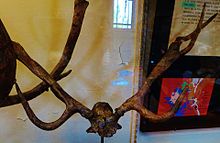Croizetoceros is an extinct genus of deer[2] which lived throughout much of Europe, first appearing during the last stages of the Miocene and living until the Early Pleistocene.
| Croizetoceros Temporal range: Late Miocene - Early Pleistocene
| |
|---|---|

| |
| Skull of Croizetoceros ramosus | |
| Scientific classification | |
| Domain: | Eukaryota |
| Kingdom: | Animalia |
| Phylum: | Chordata |
| Class: | Mammalia |
| Order: | Artiodactyla |
| Family: | Cervidae |
| Subfamily: | Cervinae |
| Tribe: | Cervini |
| Genus: | †Croizetoceros Heintz, 1970[1] |
| Type species | |
| †Croizetoceros ramosus Croizet & Jobert, 1828
(as Cervus ramosus) | |
| Species | |
| |
Taxonomy
editThe type species, Croizetoceros ramosus was originally classified as Cervus ramosus, but was found distinct enough to be placed into its own genus.[3] Many subspecies of C. ramosus have been identified throughout Europe, and another species, C. proramosus, has also been described in 1996.[4]
Description
editCroizetoceros was a mid-sized species, similar in size to the living fallow deer. It stood a little over 1 m (3.3 ft) tall and weighed around 60 kg (130 lb).[2] Croizetoceros was one of the first modern-looking deer. It had complex antlers, with four or even five short branches. They were long and lyre-shaped, with the tines branching off tangentially from the central branch.[2]
Croizetoceros was probably a browser.[5] Its teeth were characterized by a high degree of wear, indicating that it fed on abrasive plants.
References
edit- ^ "Croizetoceros". Biolib.
- ^ a b c Agustí, Jordi; Antón, Mauricio (2010). Mammoths, Sabertooths, and Hominids 65 Million Years of Mammalian Evolution in Europe. New York: Columbia University Press. p. 205. ISBN 9780231516334.
- ^ Heintz, E. (1970). "Les Cervidés villafranchiens de France et d'Espagne". Mémoires du Muséum National d'Histoire Naturelle. 22: 1–303.
- ^ Dong, W. (1996). "Les Cervidae (Artiodactyla) rusciniens (Pliocène) du Languedoc et du Roussillon (France)". Bulletin du Muséum National d'Histoire Naturelle. 18 (1): 133–163.
- ^ Strani, F. (2017). "Resource and niche differentiation mechanisms by sympatric Early Pleistocene ungulates: the case study of Coste San Giacomo". Quaternary International. 481: 157. Bibcode:2018QuInt.481..157S. doi:10.1016/j.quaint.2017.08.064. S2CID 90466225.